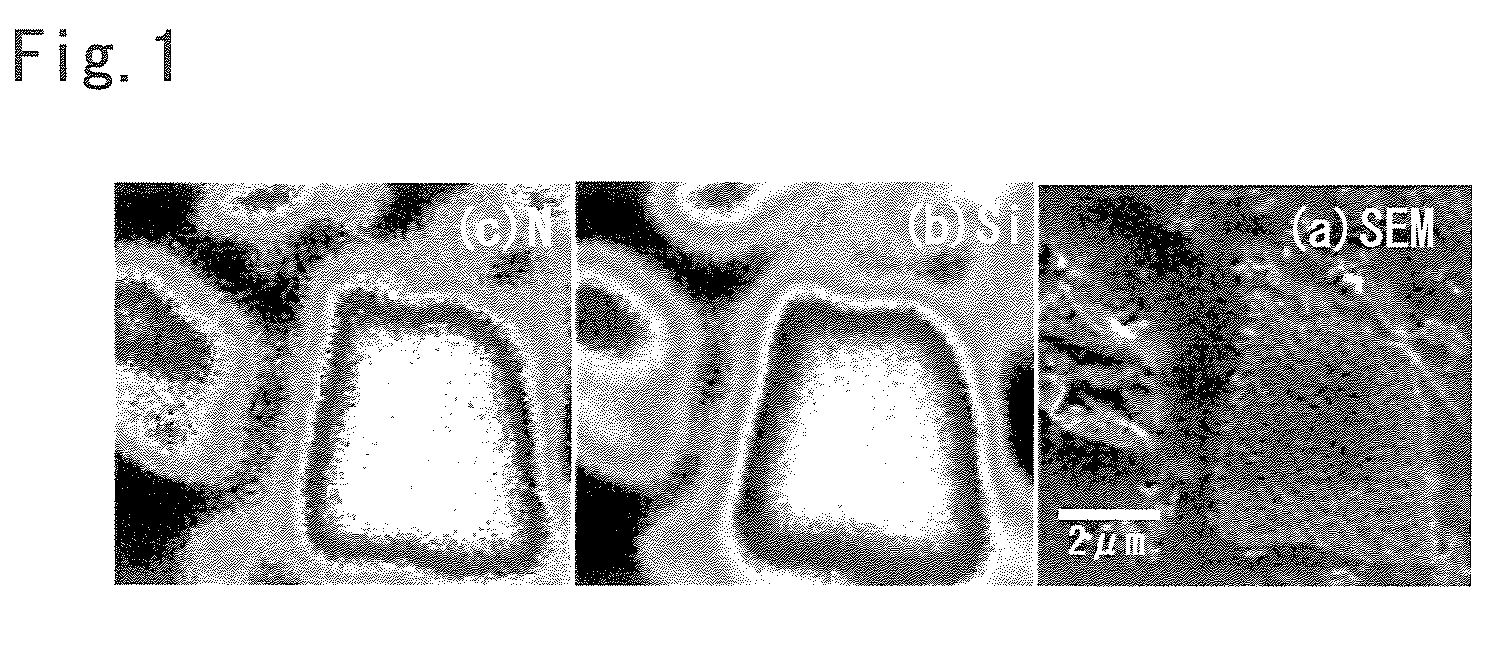Rechargeable battery with nonaqueous electrolyte, its negative electrode, and its material
- Summary
- Abstract
- Description
- Claims
- Application Information
AI Technical Summary
Benefits of technology
Problems solved by technology
Method used
Image
Examples
example 1
[0271]A film was formed using Si as the target material and an SUS plate having a thickness of 1 mm as the substrate with a direct-current sputtering apparatus (“HSM-52” manufactured by Shimadzu Corporation).
[0272]In this process, the substrate was attached to a water-cooled holder and the temperature thereof was maintained approximately 25° C. A high-purity nitrogen gas was introduced to the chamber, which had been depressurized to have an internal pressure of 4×10−4 Pa, while the opening of the main valve was being adjusted so that the pressure reached 0.16 Pa. Subsequently, a high-purity argon gas was introduced to the chamber until the pressure reached 1.6 Pa, and then a film-forming step was carried out for 180 minutes at a power density of 7.1 W / cm2. In addition, the content ratio of nitrogen in the sputtering gas was 10%.
[0273]The SUS substrate was detached and then the formed film was easily removed from the substrate as a thin section. One cycle of the abovementioned film-f...
example 2
[0311]A film was formed by electron-beam-heating vapor deposition with the vapor deposition source being pellets of the mixture containing Si particles of approximately 20 μm and graphite so that the weight ratio thereof was 8:2, the substrate being an SUS plate having a thickness of 1 mm, and the equipment being “EX-400” manufactured by ULVAC Technologies, Inc. In this process, the film-forming step was carried out in a chamber which had been depressurized to have an internal pressure of 9×10−5 Pa for 120 minutes with the emission current being 60 mA.
[0312]The SUS substrate was detached and then the formed film was easily removed from the substrate as a thin section. One cycle of the abovementioned film-forming step provided such a thin section weighing approximately 0.5 g, and this cycle was repeated until thin sections totally weighing approximately 3 g were obtained. The obtained thin sections were ground in an agate mortar, and the resulting particles were classified by size us...
example 3
[0321]A film was formed using the mixture of Si and C (a disk containing Si and C with the area ratio thereof being approximately 100:9) as the target material and a glossy SUS plate having a thickness of 1 mm as the substrate with a direct-current sputtering apparatus (“HSM-52” manufactured by Shimadzu Corporation). In this process, the SUS substrate was attached to a water-cooled holder and the temperature thereof was maintained approximately 25° C. A high-purity argon gas was introduced at a flow rate of 40 sccm to the chamber, which had been depressurized to have an internal pressure of 4×10−4 Pa, while the opening of the main valve was being adjusted so that the pressure reached 1.6 Pa. Subsequently, a film-forming step was carried out for 180 minutes at a power density of 7 W / cm2. In addition, the content ratio of oxygen in the sputtering gas was 0.001%.
[0322]The SUS substrate was detached and then the formed film was easily removed from the substrate as a thin section. One cy...
PUM
| Property | Measurement | Unit |
|---|---|---|
| Percent by atom | aaaaa | aaaaa |
| Percent by atom | aaaaa | aaaaa |
| Fraction | aaaaa | aaaaa |
Abstract
Description
Claims
Application Information
 Login to View More
Login to View More - R&D
- Intellectual Property
- Life Sciences
- Materials
- Tech Scout
- Unparalleled Data Quality
- Higher Quality Content
- 60% Fewer Hallucinations
Browse by: Latest US Patents, China's latest patents, Technical Efficacy Thesaurus, Application Domain, Technology Topic, Popular Technical Reports.
© 2025 PatSnap. All rights reserved.Legal|Privacy policy|Modern Slavery Act Transparency Statement|Sitemap|About US| Contact US: help@patsnap.com

